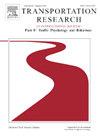Towards recognizing cognitive distraction levels with low-cost and high-sensitive measures: The effectiveness of sample, approximate, and traditional steering entropies
IF 3.5
2区 工程技术
Q1 PSYCHOLOGY, APPLIED
Transportation Research Part F-Traffic Psychology and Behaviour
Pub Date : 2025-02-01
DOI:10.1016/j.trf.2024.12.036
引用次数: 0
Abstract
Driver distraction is one of the main factors leading to traffic accidents. Due to a lack of sensitive and accessible measures, the detection of cognitive distraction levels remains challenging and resource-intensive. Based on the idea that cognitive distraction causes unpredictable steering wheel operation, we introduced approximate entropy and sample entropy to quantify the unpredictability of drivers’ steering behavior during lane keeping. In this way, two novel steering measures, i.e., approximate steering entropy (ApproSE) and sample steering entropy (SampleSE), were proposed. To explore the effectiveness of the proposed measures, a driving simulator study with 35 participants was conducted, where four levels of cognitively demanding tasks induced by verbal recall of digits were involved. The effects of cognitive distraction level on various driving performance measures along with the two proposed measures were investigated, including the standard deviation of lateral position (SDLP), steering wheel reversal rate of 0.5° (SRR0.5°), the traditional steering entropy (TradSE), etc. Subsequently, the sensitivities of the three steering entropies (i.e., ApproSE, SampleSE, TradSE) changing with increased cognitive distraction levels were compared using statistical significance, effect size, and true positive rate. Moreover, various intervals for steering wheel angle sampling while calculating entropies were compared. The results showed that cognitive distraction led to increased ApproSE and SampleSE, as well as increased TradSE, SRR0.5°and decreased SDLP significantly. Particularly, ApproSE and SampleSE were observed with higher effect size than the other driving performance measures, which suggests that ApproSE and SampleSE are more sensitive to changes in cognitive distraction level. Among the three steering entropy measures, ApproSE and SampleSE were observed with higher robustness in various sample intervals, and higher consistency across the population than TradSE. The most suggested interval for steering wheel angle sampling while calculating ApproSE and SampleSE was 200 ms. The proposed novel steering entropies along with the other existing driving performance measures could be used to develop low-cost and highly sensitive driver cognitive distraction monitoring systems in intelligent vehicles.
求助全文
约1分钟内获得全文
求助全文
来源期刊
CiteScore
7.60
自引率
14.60%
发文量
239
审稿时长
71 days
期刊介绍:
Transportation Research Part F: Traffic Psychology and Behaviour focuses on the behavioural and psychological aspects of traffic and transport. The aim of the journal is to enhance theory development, improve the quality of empirical studies and to stimulate the application of research findings in practice. TRF provides a focus and a means of communication for the considerable amount of research activities that are now being carried out in this field. The journal provides a forum for transportation researchers, psychologists, ergonomists, engineers and policy-makers with an interest in traffic and transport psychology.

 求助内容:
求助内容: 应助结果提醒方式:
应助结果提醒方式:


